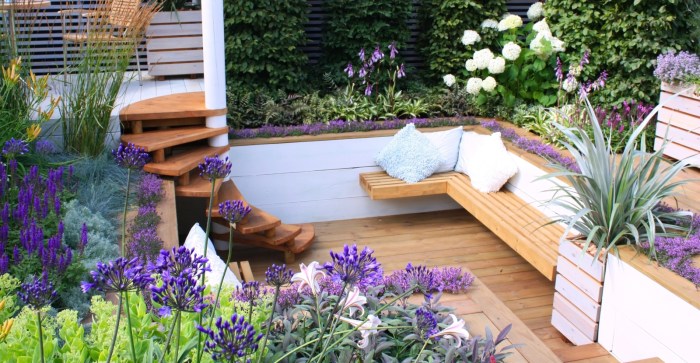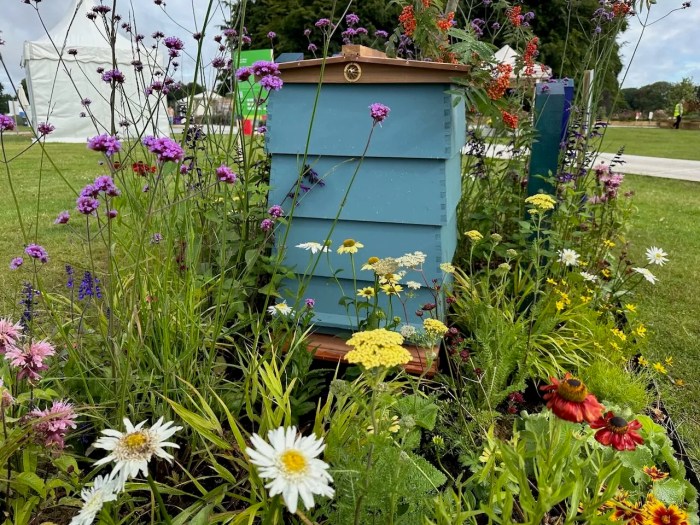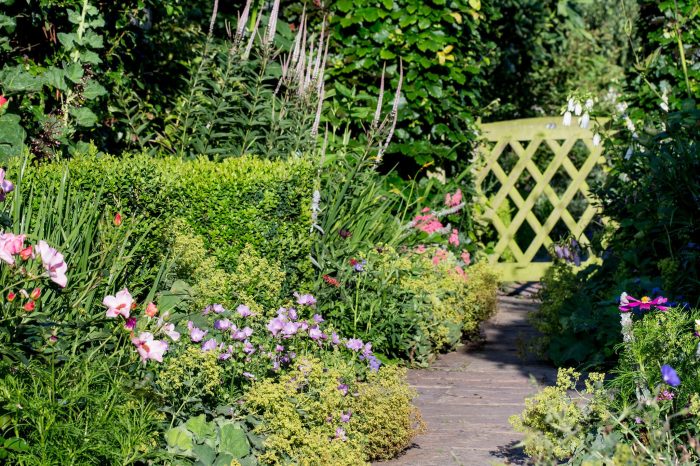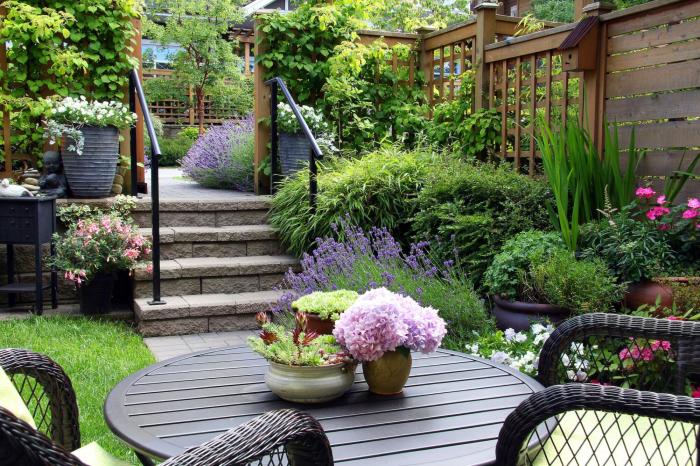Transforming your outdoor space into a vibrant, flourishing garden needn’t break the bank. This guide unveils practical strategies for crafting a stunning garden without compromising on aesthetics or depleting your wallet. We’ll explore creative planning, resourceful sourcing of plants and materials, and cost-effective maintenance techniques, all while ensuring your garden thrives.
From designing a budget-friendly layout using readily available materials to propagating plants from cuttings and seeds, we’ll cover every aspect of creating a beautiful, sustainable garden. Learn how to choose low-cost, native plants, optimize soil preparation, and implement a rainwater harvesting system. Discover clever ways to enhance your garden’s appeal using recycled materials, turning discarded items into charming garden features.
Planning & Design

Creating a beautiful garden on a budget requires careful planning and design. This involves maximizing the use of free or readily available materials, selecting low-cost plants, and employing efficient soil preparation techniques. By strategically planning your garden layout and plant choices, you can significantly reduce expenses while achieving a stunning and thriving garden.
Budget-Friendly Garden Layout
A thoughtfully designed garden layout can significantly impact both aesthetics and practicality. To minimize costs, consider utilizing readily available materials for pathways, borders, and other structural elements. For example, repurposed bricks, stones, or even large branches can create attractive pathways and borders. Similarly, pallets can be disassembled and used to create raised beds.
| Material | Cost | Source |
|---|---|---|
| Repurposed bricks/stones | $0 | Found on site or salvaged |
| Disassembled pallets | $0 | Freely available (check local regulations) |
| Large branches/logs | $0 | From yard waste or tree trimming |
| Recycled containers (pots, buckets) | $0 | Household items |
Detailed Planting Plan
Choosing the right plants is crucial for a thriving and cost-effective garden. Prioritizing low-cost, native, or easily propagated plants will minimize your upfront investment and ongoing maintenance. Native plants are well-suited to your local climate, requiring less watering and fertilization. Easily propagated plants, such as those that can be grown from cuttings or seeds, significantly reduce the need for purchasing new plants every year.
- Plant Choice 1: Sunflowers (Helianthus annuus): These are easily grown from seed, attract pollinators, and provide a vibrant display. Care requirements include full sun and well-drained soil. They are relatively drought-tolerant once established.
- Plant Choice 2: Zinnias (Zinnia elegans): These annuals are inexpensive to purchase as seeds and produce a profusion of colorful blooms throughout the summer. They require full sun and regular watering.
- Plant Choice 3: Lavender (Lavandula): A fragrant and drought-tolerant perennial, lavender can be propagated from cuttings, making it a cost-effective choice. It thrives in full sun and well-drained soil.
- Plant Choice 4: (Local Native Plant): Research native plants in your area. These require less maintenance and are better suited to your local climate and soil. Specific care requirements will vary depending on the chosen species, but often include minimal watering once established.
Cost-Effective Soil Preparation
Preparing the soil is a fundamental step in creating a successful garden. This can be achieved cost-effectively through composting and soil amendment using readily available materials. Composting transforms kitchen and yard waste into nutrient-rich soil amendment. Household scraps like fruit and vegetable peels, coffee grounds, and eggshells can be added to your compost pile.
- Composting: Collect organic materials such as vegetable scraps, yard waste, and coffee grounds. Layer them in a compost bin or designated area, alternating “greens” (nitrogen-rich) and “browns” (carbon-rich). Regularly turn the compost to aerate it. The process typically takes several months.
- Soil Amendment: Once your compost is ready, incorporate it into your garden soil. This improves soil structure, drainage, and nutrient content. Adding other readily available amendments like aged manure (if accessible and safe) can further enhance soil fertility.
- Soil Testing (Optional): For a more precise approach, consider a soil test kit to determine your soil’s pH and nutrient levels. This allows for targeted amendments based on specific needs.
Sourcing & Planting

Creating a beautiful garden on a budget often hinges on smart sourcing and planting strategies. By carefully considering where you acquire your plants and employing propagation techniques, you can significantly reduce costs while still achieving a thriving garden. This section will explore various plant sourcing options and detail the process of propagating plants from cuttings and seeds.
Plant Sourcing: Cost, Availability, and Plant Health Comparison
Choosing the right source for your plants is crucial for both cost-effectiveness and the overall health of your garden. The following table compares three common options: nurseries, garden centers, and seed starting. Plant swaps offer another avenue, but their cost is negligible (often just a small donation or exchange) and availability and health vary greatly depending on the swap itself.
| Source | Cost | Availability | Plant Health |
|---|---|---|---|
| Nurseries | Generally higher, but often offers larger, more established plants. | Wide selection, often specializing in specific plant types. Seasonal variations exist. | Typically high, with plants carefully nurtured in controlled environments. |
| Garden Centers | Moderate cost, offering a balance between price and selection. | Good selection, often with a broader range of common garden plants. Seasonal availability. | Generally good, though plant health can vary depending on the center’s practices. |
| Seed Starting | Lowest initial cost, but requires time, effort, and resources. | Wide selection, limited only by seed availability. Can source unique or heirloom varieties. | Plant health depends on the grower’s skill and care. Requires attention to detail for germination and seedling care. |
Propagating Plants from Cuttings
Propagating plants from cuttings is a cost-effective way to expand your garden without repeatedly purchasing new plants. This method involves taking a cutting from an existing plant and encouraging it to root and grow into a new, independent plant.
Image Description: A close-up image showing a cutting from a succulent plant, about 4 inches long, with leaves at the top and the bottom end dipped in rooting hormone powder. The cutting is placed in a small pot filled with a moist, well-draining potting mix. A clear plastic bag is loosely placed over the pot to maintain humidity.
Process: Select a healthy stem cutting, ideally from new growth. Remove lower leaves to prevent rot. Dip the cut end in rooting hormone (optional but beneficial). Plant the cutting in a moist potting mix and cover with a plastic bag or humidity dome to maintain high humidity. Keep the soil consistently moist but not waterlogged. Roots typically develop within several weeks to months, depending on the plant type. Once roots are established, the new plant can be transplanted.
Propagating Plants from Seeds
Starting plants from seeds offers the most significant cost savings, especially when growing many plants. It also allows for the selection of unique or heirloom varieties often unavailable from other sources.
Image Description: A close-up image showing a small seed tray filled with a well-draining seed-starting mix. Tiny seeds are evenly spaced across the surface of the mix, lightly covered with a thin layer of soil. The tray is sitting in a shallow tray of water, demonstrating the bottom-watering technique.
Process: Choose high-quality seeds from a reputable source. Sow seeds according to package instructions, considering the ideal depth and spacing. Maintain consistent moisture and warmth. Once seedlings have developed a few true leaves, they can be transplanted into individual pots or directly into the garden.
Low-Maintenance, Budget-Friendly Plants
Selecting low-maintenance plants minimizes the time, effort, and resources required for garden upkeep. Many inexpensive options thrive with minimal intervention.
Many low-maintenance plants are well-suited to various garden styles. The following list categorizes some popular choices based on their sun/shade requirements and plant type:
| Plant Type | Sun/Shade | Examples | Garden Style |
|---|---|---|---|
| Perennials | Full Sun | Coneflowers, Lavender, Daylilies | Cottage Garden, Butterfly Garden |
| Perennials | Partial Shade | Hostas, Astilbe, Ferns | Woodland Garden, Cottage Garden |
| Annuals | Full Sun | Zinnias, Marigolds, Sunflowers | Cottage Garden, Cut Flower Garden |
| Annuals | Partial Shade | Impatiens, Coleus, Begonias | Shade Garden, Container Garden |
| Succulents | Full Sun | Sedum, Echeveria, Sempervivum | Xeriscape, Rock Garden |
| Vegetables | Full Sun | Tomatoes, Peppers, Beans | Vegetable Garden |
| Herbs | Full Sun/Partial Shade (varies by herb) | Rosemary, Thyme, Mint | Herb Garden, Cottage Garden |
Maintenance & Enhancement

Creating and maintaining a beautiful garden needn’t break the bank. With a little planning and some clever strategies, you can keep your garden thriving while minimizing expenses and maximizing its aesthetic appeal. This section focuses on practical, cost-effective maintenance techniques and creative enhancement ideas.
Routine Garden Maintenance Schedule
A regular maintenance schedule is crucial for a healthy and visually appealing garden. Consistent care prevents problems from escalating and saves you money in the long run by preventing the need for extensive repairs or replacements. The following schedule prioritizes cost-effective practices.
- Watering: Deep, infrequent watering is more effective than shallow, frequent watering and helps conserve water. Cost: Free (using rainwater harvesting system described below). Alternatively, minimal cost for using a garden hose connected to a tap.
- Weeding: Regular weeding prevents weeds from competing with your plants for resources. Cost: Free (hand weeding). For larger areas, a small investment in a hoe can significantly reduce time and effort.
- Pruning: Regular pruning promotes healthy growth and improves the overall appearance of your plants. Cost: Free (using hand pruners). For larger trees or shrubs, professional pruning might be necessary, but this should be infrequent.
- Pest and Disease Control: Regularly inspect plants for pests and diseases. Early detection allows for less intensive (and cheaper) treatment methods such as hand-picking pests or using natural remedies. Cost: Minimal to moderate depending on the severity of the issue and the chosen method. Organic pest control solutions are generally less expensive than chemical treatments.
- Mulching: Applying mulch around plants helps retain moisture, suppress weeds, and regulate soil temperature. Cost: Minimal (using readily available materials like shredded leaves or wood chips). Purchasing mulch can be more expensive but is a one-time cost that saves money in the long run.
Rainwater Harvesting System for Irrigation
Implementing a rainwater harvesting system is an excellent way to reduce water bills and contribute to environmental sustainability. This system collects rainwater from rooftops or other surfaces and stores it for later use in irrigation.
Diagram 1: Simple Rainwater Harvesting System
Imagine a simple diagram showing a downspout from a roof gutter connected to a rain barrel via a length of PVC pipe. The rain barrel has a tap near the bottom. The barrel is placed on a slightly elevated platform to allow for gravity-fed watering.
Diagram 2: More Complex System
This diagram depicts a more sophisticated system with multiple rain barrels connected in series or a larger underground tank. It may also include a filter to remove debris and a pump for easier distribution to garden beds. The system could even include a water level sensor to alert you when the tank is full or low.
The cost of a rainwater harvesting system varies greatly depending on its complexity. A simple system using repurposed materials can be very inexpensive, while a more elaborate system may require a moderate investment in materials and potentially professional installation.
Garden Enhancement with Recycled Materials
Repurposing materials adds character and reduces costs while promoting sustainability. Here are some examples:
| Repurposed Material | Application in Garden Design |
|---|---|
| Old tires | Raised garden beds, vertical planters |
| Broken pottery and tiles | Mosaic pathways, edging for flowerbeds |
| Glass bottles | Decorative edging, stake markers |
| Wooden pallets | Vertical planters, trellises, edging |
| Metal cans | Miniature planters, decorative accents |
Ending Remarks

Creating a beautiful garden on a budget is achievable with careful planning and resourceful techniques. By embracing DIY methods, utilizing readily available materials, and selecting low-maintenance plants, you can cultivate a thriving and visually appealing outdoor space without exceeding your financial limits. Remember, the joy of gardening lies not just in the final result but in the process of nurturing and creating something beautiful, sustainably, and affordably.